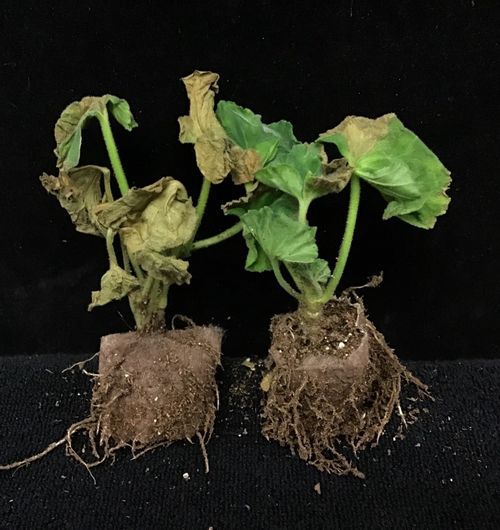Michigan State University a ‘pioneer’ in plant pest and disease response
MSU Plant & Pest Diagnostics supports plant agriculture in Michigan and the Great Lakes States through comprehensive diagnostic network

EAST LANSING, Mich. – In 1999, Michigan State University, supported by Project GREEEN, MSU AgBioResearch and MSU Extension, established MSU Plant & Pest Diagnostics – a comprehensive plant pest and disease diagnostic team providing Michigan’s vast and diverse population of plant growers a reliable, efficient and accurate resource to identify and treat chronic and emerging plant threats.
In more than two decades since its inception, MSU Plant & Pest Diagnostic scientists have evaluated over 80,000 unique samples and supported the discovery, containment and treatment of numerous environmentally and economically catastrophic plant threats.

“Our mission at MSU Plant & Pest Diagnostics is to do rapid and accurate diagnoses of plant problems for anyone that may have a plant problem – be it disease, insects, weed identification or infestation, nematode infestation, and the whole spectrum of plant pests,” said Ray Hammerschmidt, faculty coordinator of MSU Plant and Pest Diagnostics and Professor Emeritus of Plant Pathology at MSU.
With the establishment of the lab, MSU became unique among U.S. universities in its ability to provide comprehensive plant diagnostic services with the ability to handle all major plant diagnostic disciplines under one roof, streamlining MSU’s ability to identify and respond to the needs of growers across Michigan.
“We are the first and only plant diagnostic lab housed at a land-grant university with on-staff experts and services for all four plant pest disciplines – pathology, entomology, nematology, and weed science,” Hammerschmidt said. “The impact the lab has had on Michigan’s various plant industries reflects the role MSU Plant and Pest Diagnostics has played as a core program of Project GREEEN.”
Diagnosticians at MSU collaborate extensively with diagnosticians in the Michigan Department of Agriculture and Rural Development (MDARD) Plant Pathology Laboratory. Good communication and collaboration between the labs provides an early warning of pests and diseases that are trending in the state. Additionally, MDARD lab staff have undergone training in MSU’s lab so as to be able provide backup when a significant disease is identified and a large number of samples are anticipated.
“MDARD pest response specialists often seek advice from MSU experts on pest and disease response situations. They help to inform many of our pest detection efforts and are crucial to the success of those efforts. Michigan has been a pioneer in this type of collaboration,” said Robin Rosenbaum, Plant Health Section Manager and State Plant Regulatory Official at MDARD.
MSU Plant & Pest Diagnostics accepts samples from a wide range of clients, including growers, residents, nursery and landscape professionals, agribusiness specialists, pest control personnel, county extension and campus specialists and regulatory agencies.
Samples submitted to the laboratory can be analyzed for the presence of insect pests, plant pathogens, nematodes, or indications of abiotic injury. The lab also offers plant and insect identification services and herbicide resistance testing. Diagnostic staff include:
- Jan Byrne, Plant Pathology Diagnostician
- Erin Hill, Weed Science Diagnostician
- Laura Miles, Molecular Detection and Diagnostics
- Howard Russell, Insect/Arthropod Diagnostician
- Jackie Smith, Diagnostic Technician and Billing Coordinator
- Angela Tenney, Nematode Diagnostician/Plant Identification

Consolidating thousands of samples into one full-service diagnostic lab allows MSU to address a high volume, as well as tackle highly complex plant disease and pest problems. Byrne credits the willingness of growers and the Michigan agricultural community to submit samples and work alongside MSU researchers and Extension specialists to diagnose and treat issues for helping to build a dynamic response network.
“MSU Plant & Pest Diagnostics receives thousands of samples from every type of grower in the state, so they're going to have the opportunity to see new and exotic pests long before anybody else might become aware,” said Rosenbaum, who also serves as also serves as the State Plant Regulatory Officer. “The detection of Ralstonia in 2020 was a fantastic example of how MSU’s early detection impacted the spread of a major plant disease.”
2020 Ralstonia solanacearum detection

“In April 2020, I got a call from Jan Byrne saying ‘I have this sample that looks suspect for Ralstonia solanacearum,’ which is a very significant pathogen of geraniums, but also potatoes and tomatoes,” Rosenbaum said. “USDA considers this a select agent, because it can have a large impact on vital agricultural crops if it gets into the environment.”
MSU Plant and Pest Diagnostics worked with MDARD and USDA’s Animal and Plant Health Inspection Service (APHIS) to confirm the detection of a type of Ralstonia solanacearum that can cause diseases such as brown rot of potato, bacterial wilt of tomato and eggplant, and southern wilt of geranium. It was the first confirmed detection of the pathogen in a U.S. greenhouse since 2004. On June 11, 2020, APHIS and its state partners successfully eliminated the pathogen from all U.S. greenhouses.
MDARD and MSU Extension sprang into action after the detection, organizing efforts to reach out to Michigan’s greenhouses to identify, contain and destroy plants that potentially carried the pathogen to prevent the spread.
“In the end, I think there were more than 600 facilities impacted nationwide and over 621,000 plants destroyed, and it all started with a phone call from Jan Byrne at the MSU plant diagnostic lab,” Rosenbaum said.
A growing diagnostic network
MSU Plant and Pest Diagnostics serves as the hub for the North Central Plant Diagnostic Network – consisting of the six Great Lakes States plus Iowa and Missouri.
The National Plant Diagnostic Network was established in 2002 by USDA - NIFA (National Institute of Food and Agriculture) and the Office of Homeland Security to enhance agricultural biosecurity by detecting instances of biological threats, serve clientele on specific plant pests and disease, and protect national plant health by quickly detecting and accurately identifying plant pests and pathogens and communicating these diagnoses to stakeholders.
MSU Plant & Pest Diagnostics partners with Michigan’s various plant commodity boards and committees to coordinate efforts to address emerging issues as well as maintain active screening programs through periodic check-off programs and sampling.
Dennis Pennington, MSU Extension Wheat Specialist, coordinates with The Michigan Wheat Program, Michigan’s wheat growers, and MSU Plant and Pest Diagnostics to ensure testing and early detection of any issues that may arise with wheat crops across Michigan, helping each farmer secure yields as well as preventing potential spread of plant diseases. The Michigan Wheat Board’s check-off program pays diagnostic fees for Michigan's wheat producers to send samples into the lab.

“As more farms participate in the check-off program, it helps us better identify as a state what disease problems we might be facing or nutrient problems we might be facing each year. That allows us to design educational programs to help address those issues as they rise up,” said Pennington, whose role is funded through a partnership among MSU AgBioResearch, MSU Extension and the Michigan Wheat Committee.
The Michigan Soybean Committee assists the state’s soybean growers by covering the cost of herbicide resistance screening for soybeans as well as soybean cyst nematode (SCN) screening. MSU Extension reports show the soybean cyst nematode causes more yield loss than any other soybean disease in North America. In Michigan alone, SCN causes more than $40 million of economic losses per year.
2022 saw an increase in corn samples delivered to the lab, “not because there was a disease outbreak, but because growers had huge losses from corn tar spot last year, a relatively new fungal disease that we're still learning how to manage,” Byrne said. To make informed decisions about fungicide applications, growers were carefully scouting fields for signs of tar spot and brought samples with suspicious symptoms to the lab for further evaluation.
Byrne said her role with MSU Plant & Pest Diagnostics allows her to balance diagnostics, research and helping growers on a personal basis. “It’s really rewarding and interesting to be at the intersection of some really cool research our faculty is pursing and our growers and partners in the agricultural industry. I get to pass diagnostic information along to our growers in a way that makes it meaningful and tangible to them."
Weed Science
Weed Science Diagnostician Erin Hill specializes in the diagnosis and treatment of abiotic plant stressors with an emphasis on herbicide-related injury, herbicide resistance screening, weed control recommendations, and collaborating on plant and seed identification.

Weed management is one of the most costly components of agriculture, which can be exacerbated when herbicides are no longer effective. Hill works with growers across the state and researchers at MSU to test for herbicide resistance in various weeds species. She partners with MSU Weed Geneticist Eric Patterson to develop and test molecular tools that may help identify resistance more quickly. Decades of testing and data collection at MSU allowed Hill and her team to design a virtual map showing confirmed cases of herbicide resistance at the county level.
Hill also works with MSU Forages and Cover Crops Specialist Kim Cassida on how best to test soils for traces of alfalfa autotoxicity. Autotoxicity, a plant being toxic to its own species, can cause planting failures when alfalfa is planted to quickly after a previous alfalfa crop. The tests being developed aim to prevent such losses and better inform growers.
Years of experience working with Michigan agriculture combined with the latest technology and support from the lab’s partners have allowed diagnosticians to incorporate new techniques and diagnostic methods into tried-and-true preventative and screening programs that ultimately give Michigan’s growers the best possible diagnosis and treatment plan for their individual farm needs, Hammerschmidt said
“What our diagnosticians do is parallel to what happens in human medicine diagnostics. If you don't have a proper diagnosis, you can't provide the proper solution,” Hammerschmidt said. “The lab is a much different place than it was 20 years ago, even five or six years ago, with new technologies and methods that enable the lab to provide even better services to their clients. Additionally, Michigan agriculture is facing a lot of changes with climate change; changes in cropping systems; fungicide, insecticide and herbicide resistance. Our efforts allow us to stay on top of those changes and provide recommendations and information back to the community at large. It’s been quite rewarding and satisfying to see the lab’s evolution.”



 Print
Print Email
Email




